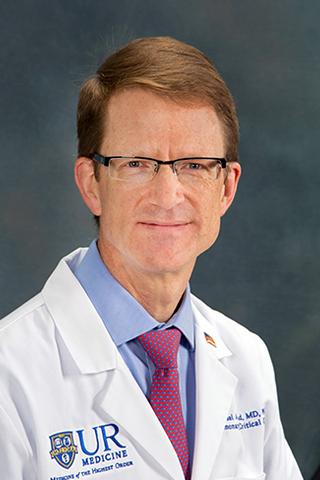Interventional Pulmonary Program
Pulmonologists play an important role in the diagnosis and accurate staging of lung cancer and intrathoracic malignancies. Headed up by Dr. Michael Nead, a Diplomate in Interventional Pulmonology, the Interventional Pulmonary Program has over a decade of experience using endobronchial ultrasound guided biopsy (EBUS) and electromagnetic navigational bronchoscopy (ENB) to diagnose and stage abnormalities seen on chest imaging.
EBUS uses real-time ultrasound imaging to precisely biopsy even the smallest of lymph nodes along airways. Meanwhile, ENB is a powerful bronchoscopic technique using ‘GPS’-like technology to guide tools to more distant lesions in the lung for biopsy. ENB may be paired with radial endobronchial ultrasound to further enhance biopsy accuracy. URMC was a top enroller and active participant in the multi-center, international NAVIGATE study looking at patient outcomes with ENB, an experience our providers use to optimize care for our patients.
Pulmonologists can help even beyond diagnosis. Both cancer and its treatment may make breathing difficult for patients by impacting the lung and airways. Even some benign diseases cause shortness of breath that can benefit from Interventional Pulmonary techniques. Some techniques include:
- Airway Stent Placement: Stents are tube-like devices that can hold open a narrowed airway.
- Balloon Dilation: Ballooning open a focal airway narrowing can help breathing.
- Cryoablation: Cryo (or cold) techniques – freeze tumors or airway lesions, much like freezing warts. The cryo treatment may be done with a probe or by spray, depending on the situation.
- Fiducial Marker Placement: Fiducials are small inert metal markers placed in and around a cancer to help a thoracic surgeon find a small lesion to remove it, or to help a radiation oncologist use stereotactic radiation to destroy a small lesion. Fiducial markers are often placed with navigational bronchoscopy.
- Tumor Debulking: Cancer in airways can sometimes be destroyed or removed bronchoscopically. Argon plasma coagulation, electrocautery forceps and loops are just some of the tools that may be used.
- Whole Lung Lavage: Pulmonary alveolar proteinosis is a disease that can require the entire lung to be ‘washed’. Our interventional program performs whole lung lavage, including with extracorporeal membrane oxygenation (ECMO) support in severe cases.
Pleural Effusion
A pleural effusion is fluid around the lung that affects breathing by pushing on the lung and the diaphragm. The Interventional Program can use Point of Care Ultrasound (POCUS) in clinic to assess the fluid, and several options exist for management:
- Thoracentesis: This common outpatient procedure simply drains the fluid from around the lung.
- Indwelling Pleural Catheter Placement: For recurrent effusions, an indwelling drain provides patients flexibility to be drained at home, often with assistance from a visiting nurse or family member.
- Pleurodesis: Chemicals such as talc may be placed in the space around the lung to ‘scar’ it into position.
Our Team

Michael A. Nead, MD, PhD
Medical Director, Interventional Pulmonology

